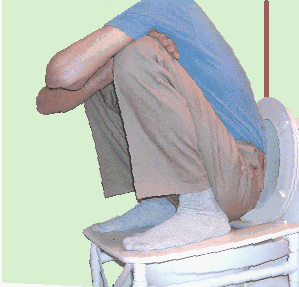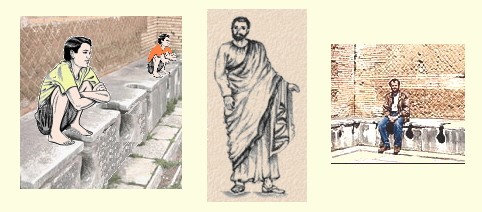NaturesPlatform- Man, like his fellow primates, has always used the squatting position for elimination . Infants of every culture instinctively adopt this posture to relieve themselves. Although it may seem strange to someone who has spent his entire life deprived of the experience, this is the way the human body was designed to function..
. Infants of every culture instinctively adopt this posture to relieve themselves. Although it may seem strange to someone who has spent his entire life deprived of the experience, this is the way the human body was designed to function..
And this is the way our ancestors performed their bodily functions until the middle of the 19th century. Before that time, chair-like toilets had only been used by royalty and the disabled. But with the advent of indoor plumbing in the 1800’s, the throne-like water closet was invented 22 to give ordinary people the same “dignity” previously reserved for kings and queens. The plumber and cabinet maker who designed it had no knowledge of human physiology – and sincerely believed that they were improving people’s lives..
Seven Advantages of Squatting
# Makes elimination faster, easier and more complete. This helps prevent “fecal stagnation,” a prime factor in colon cancer, appendicitis and inflammatory bowel disease.# Protects the nerves that control the prostate, bladder and uterus from becoming stretched and damaged.
# Securely seals the ileocecal valve, between the colon and the small intestine. In the conventional sitting position, this valve is unsupported and often leaks during evacuation, contaminating the small intestine.
# Relaxes the puborectalis muscle which normally chokes the rectum in order to maintain continence.
# Uses the thighs to support the colon and prevent straining. Chronic straining on the toilet can cause hernias, diverticulosis, and pelvic organ prolapse.
# A highly effective, non-invasive treatment for hemorrhoids, as shown by published clinical research.
# For pregnant women, squatting avoids pressure on the uterus when using the toilet. Daily squatting helps prepare one for a more natural delivery.
The new device symbolized the “progress” and “creativity” of western civilization. It showed that Man could “improve” on Nature and transcend the primitive cultural practices followed by the poor “benighted” natives in the colonies. The “White Man’s Burden” typified the condescending Victorian attitude toward other races and cultures.
Squat appendages to home toilets are being reintroduced on recommendation of medical personnel.
The British plumbing industry moved quickly to install indoor plumbing and water closets throughout the country. The great benefits of improved sanitation caused people to overlook a major ergonomic blunder: The sitting position makes elimination difficult and incomplete, and forces one to strain.
Those who could not overlook this drawback had to keep silent, because the subject was considered unmentionable. Furthermore, how could they criticize the “necessary” used by Queen Victoria herself? (Hers was gold-plated, befitting the self-styled “Empress of India.”)
So, like the Emperor’s New Clothes, the water closet was tacitly accepted. It was a grudging acceptance, as evidenced by the popularity of “squatting stools” sold in the famous department store, Harrods of London. As shown below on the left, these footstools merely elevated one’s feet in a crude attempt to imitate squatting.
The rest of Western Europe, as well as Australia and North America, did not want to appear less civilized than Great Britain, whose vast empire at the time made it the most powerful country on Earth. So, within a few decades, most of the industrialized world had adopted “The Emperor’s New Throne.”
150 years ago, no one could have predicted how this change would affect the health of the population. But today, many physicians blame the modern toilet for the high incidence of a number of serious ailments. Westernized countries have much higher rates of colon and pelvic disease, as illustrated by this report in the Israel Journal of Medical Science:
The prevalences of bowel diseases (hemorrhoids, appendicitis, polyps, ulcerative colitis, irritable bowel syndrome, diverticular disease, and colon cancer) are similar in South African whites and in populations of prosperous western countries. Among rural South African blacks with a traditional life style, these diseases are very uncommon or almost unknown.





